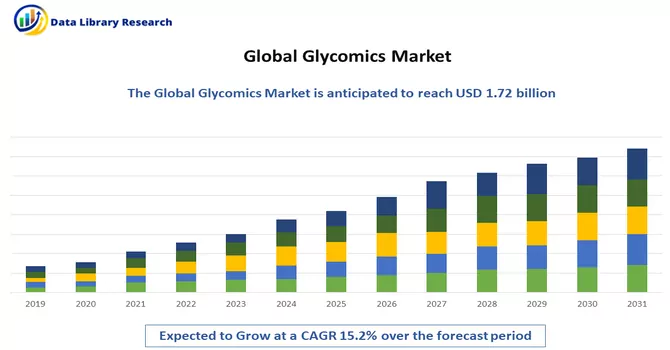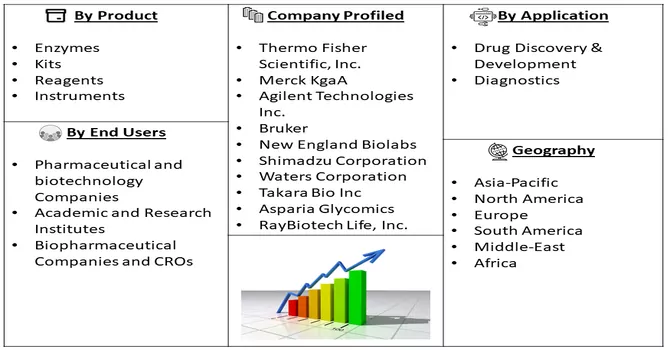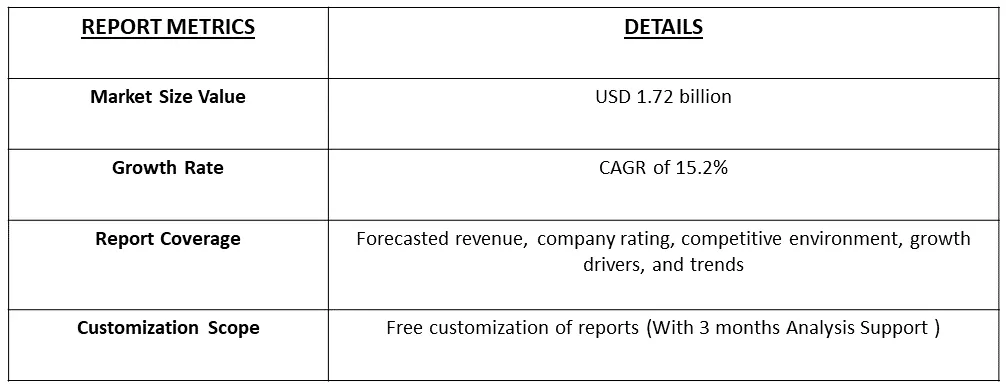The global glycomics market, valued at USD 1.72 billion in 2022, is projected to exhibit a compound annual growth rate (CAGR) of 15.2% from 2023 to 2030.

Get Complete Analysis Of The Report - Download Free Sample PDF
Glycomics is the study of the structure, composition, biosynthesis, and function of complex carbohydrates, also known as glycans, within a biological system. It involves the comprehensive analysis of the entire complement of carbohydrates, including sugars, and their interactions with proteins, lipids, and other molecules. Glycomics plays a crucial role in understanding the roles of glycans in various biological processes, such as cell signalling, immune response, and disease development. The field encompasses techniques for analyzing and characterizing glycan structures, as well as investigating their functions and implications in health and disease.
The key drivers of this market include technological advancements in glycomics instruments, increased government investment in research, and the growing emphasis of pharmaceutical and biotechnology companies on novel drug development. Additionally, the rising focus on glycobiology research studies, as exemplified by initiatives like the Lebrilla League at the University of California, is contributing significantly to the overall growth of the market.
Market Segmentation: The Glycomics Market is Segmented by Product (Enzymes, Kits, Reagents, and Instruments), Application (Drug Discovery & Development, and Diagnostics), End Use (Pharmaceutical and biotechnology Companies, Academic and Research Institutes, Biopharmaceutical Companies and CROs) and Geography (North America, Europe, Asia-Pacific, Middle East and Africa, and South America). The report offers the value (in USD million) for the above segments.

For Detailed Market Segmentation - Download Free Sample PDF\
The ongoing technological advancements in glycomics instruments, such as mass spectrometry and chromatography, are driving innovation in glycomics research. Improved analytical tools enable more accurate and detailed analysis of complex glycan structures. Growing investments in research, both by governments and private entities, are fostering developments in glycomics. This heightened focus on understanding complex carbohydrates contributes to the expansion of the glycomics market.
Market Drivers:
Increasing Focus on Glycomics and Proteomics Research
The increasing focus on glycomics and proteomics research is a noteworthy trend in the field of glycomics. This trend is characterized by a growing emphasis on understanding the intricate interplay between glycomes (the entirety of glycans in a biological system) and proteomes (the complete set of proteins). The combined analysis of glycomes and proteomes contributes to the identification of potential disease biomarkers. Understanding alterations in glycan and protein profiles in various diseases can aid in the discovery of diagnostic markers and therapeutic targets, particularly in conditions where glycosylation plays a crucial role.
Moreover, advances in analytical technologies, such as mass spectrometry and high-performance liquid chromatography, have facilitated the simultaneous profiling of glycomes and proteomes. These technologies enable researchers to explore the complex landscape of glycoproteins, glycosylation patterns, and protein functions. Thus, such factors are expected to drive the growth of the market over the forecast period.
Rising R & R&D investments by Pharmaceutical and Biotechnology Companies and Technological Advancements
The field of glycobiology has witnessed substantial growth in recent years, driven by its diverse applications in diagnostics, drug discovery, and personalized medicine. The heightened interest in unravelling the impact of glycomics on disease profiling and biological processes has sparked increased research and development endeavours in glycomics. A notable collaboration exemplifying this trend occurred in April 2021 when the Canadian Glycomics Network partnered with BridgeBio Pharma, Inc. This collaboration aimed to translate scientific insights from glycomics research into potential treatments for individuals with genetic diseases. The surge in research activities is further fueled by augmented investments from governmental bodies and non-profit organizations.
The financial support provided by these entities has empowered researchers to devise innovative tools in the realms of glycomics and glycobiology. Notably, ongoing funding programs are dedicated to exploring the potential applications of glycomics in diagnostics and precision medicine, thereby fostering greater adoption within the industry. For instance, in July 2020, GlycoNet, a Canadian Network of Centers of Excellence, secured funding amounting to USD 16.3 million. This funding infusion was geared towards fortifying GlycoNet's efforts in glycomic research with a focus on enhancing human health outcomes. The substantial funding was allocated to GlycoNet due to its position as a leading hub with a robust community of researchers specializing in glycobiology.
Market Restraints:
Stringent Government Policies and Regulations
The growth of the glycomics market may encounter challenges due to stringent government policies and regulations. Regulatory frameworks, including compliance requirements and approval processes, are pivotal aspects that can influence the development and commercialization of glycomics-related products. Stringent regulations are established to ensure the safety, efficacy, and quality of healthcare and research interventions, but they can also introduce complexities and potential delays.
Navigating through regulatory pathways demands substantial investments in terms of time, resources, and expertise. Meeting compliance standards, obtaining necessary approvals, and addressing regulatory concerns may pose hurdles for companies involved in glycomics research and product development. The intricacies of adherence to regulatory requirements can slow down the market's growth trajectory, affecting the speed at which novel glycomics solutions reach the market. To mitigate these challenges, stakeholders in the glycomics industry need to proactively engage with regulatory authorities, stay abreast of evolving compliance standards, and invest in robust regulatory strategies. By fostering transparent communication and collaboration with regulatory bodies, companies can enhance their ability to bring innovative glycomics technologies and products to fruition while maintaining adherence to regulatory guidelines.
The COVID-19 pandemic has had varying impacts on the glycomics market. While certain aspects of the industry faced challenges, others experienced opportunities and growth. The pandemic led to disruptions in laboratory activities and research, affecting ongoing glycomics projects. Lockdowns, social distancing measures, and restrictions on non-essential activities hindered the smooth progression of experiments and data collection. The pandemic accelerated the adoption of virtual collaboration tools and platforms, allowing researchers to collaborate remotely. Virtual conferences, webinars, and collaborative platforms became essential for knowledge exchange in the glycomics community. The pandemic underscored the importance of telemedicine and personalized medicine. Glycomics, with its role in understanding individual variations in glycans, gained relevance in the context of developing personalized therapeutic approaches.
Segmental Analysis:
Enzymes Segment is Expected to Witness Significant Growth Over the Forecast Period
Enzymes play a pivotal role in glycomics, a field of study focused on the comprehensive analysis of glycans—the complex carbohydrate molecules that are integral to various biological processes. Enzymes are essential tools in glycomics research, aiding in the characterization, manipulation, and understanding of glycans. Enzymes are utilized to enzymatically process and modify glycans, enabling researchers to create specific glycan structures for study. Glycosidases, glycosyltransferases, and other glycan-modifying enzymes are employed to selectively cleave or attach sugar residues, allowing the controlled manipulation of glycans. Glycan release from glycoproteins or glycolipids is often achieved through enzymatic cleavage using enzymes such as PNGase F (Peptide N-Glycosidase F) or endoglycosidases. Thus, owing to such benefits the segment is expected to witness significant growth over the forecast period.
Drug Discovery & Development Segment is Expected to Witness Significant Growth Over the Forecast Period
Glycomics, the study of complex carbohydrate structures known as glycans, plays a crucial role in drug discovery and development. Understanding the intricate roles of glycans in biological processes has become essential for identifying new drug targets, developing therapeutic interventions, and advancing precision medicine. Glycomics support the concept of personalized medicine by providing insights into individual variations in glycan profiles. Tailoring drug therapies based on patient-specific glycan patterns can improve treatment efficacy. Thus, owing to such advantages, the segment is expected to witness significant growth over the forecast period.
Pharmaceutical & Biotechnology Companies Segment is Expected to Witness Significant Growth Over the Forecast Period
Pharmaceutical and biotechnology companies are actively engaged in harnessing the potential of glycomics to advance research, drug development, and therapeutic interventions. The intricate study of glycans and their roles in biological processes has become a focal point for these companies. Pharmaceutical and biotech companies leverage glycomics to identify disease-specific glycan biomarkers. Glycan profiling aids in discovering novel biomarkers associated with various diseases, including cancer, neurodegenerative disorders, and autoimmune diseases. Thus, pharmaceutical and biotechnology companies recognize the pivotal role of glycomics in advancing therapeutic strategies. The integration of glycomics into drug discovery and development processes is shaping the landscape of precision medicine, biomarker discovery, and the pursuit of innovative therapies for various diseases. As the field of glycomics continues to evolve, companies remain at the forefront of leveraging its potential for improving patient outcomes and addressing unmet medical needs.
North America Region is Expected to Witness Significant Growth Over the Forecast Period
The prominence of the glycomics industry is notably evident in North America, where the region secured due to the collective factors propelling the market are deeply rooted in the region's characteristics, including advanced economies, a well-established healthcare infrastructure, the presence of key industry players, and their strategic initiatives. One of the driving forces in the region is the escalating demand for cutting-edge therapeutics, aligning with the ongoing trend of innovation in healthcare solutions. Furthermore, the glycomics sector in North America benefits from substantial government support, exemplified by initiatives such as funding for research and development (R&D) activities.
An illustrative example of this support is the introduction of the Glycoscience program by the National Institutes of Health (NIH) in April 2023. This initiative is strategically designed to promote and advance research in glycobiology, particularly emphasizing the field of glycan science. The program reflects a commitment to fostering scientific exploration in glycomics, showcasing the region's dedication to pushing the boundaries of glycoscience research.
Thus, North America's leadership in the glycomics industry is a confluence of economic strength, a robust healthcare ecosystem, active industry players, and a proactive approach to research support. This regional dominance is set to contribute significantly to the ongoing growth and evolution of the glycomics market.

Get Complete Analysis Of The Report - Download Free Sample PDF
Major industry players are implementing diverse strategic initiatives to uphold their market prominence. These strategic endeavours play a pivotal role in strengthening the business prospects of market players. Glycan systems within the field of glycobiology play a critical role in comprehending diverse biological systems. This understanding has empowered manufacturers to pioneer the development of innovative therapeutics and precise diagnostic kits. Some of the prominent key players in the global glycomics market include:
Recent Development:
1) in April 2021 BridgeBio Pharma, Inc. and Canadian Glycomics Network (GlycoNet) collaborated to discover potential treatments for genetic conditions through glycomics research.
2) In September 2021, Investigators at the University of California San Diego developed a tool that permits glycomics datasets to be examined using AI and other machine learning methods. The investigators named the approach as GlyCompare. It takes a systems-level perception that accounts for shared biosynthetic pathways of glycans within and across samples. With this approach, the researchers aim to develop clinical breakthroughs in cancer diagnostics.
Q1. What was the Glycomics Market size in 2022?
As per Data Library Research the global glycomics market, valued at USD 1.72 billion in 2022
Q2. At what CAGR is the glycomics market projected to grow within the forecast period?
Glycomics Market is projected to exhibit a compound annual growth rate (CAGR) of 15.2% over the forecast period.
Q3. What Impact did COVID-19 have on the Glycomics Market?
The COVID-19 pandemic has had varying impacts on the glycomics market. While certain aspects of the industry faced challenges, others experienced opportunities and growth. For more insights request a sample here.
Q4. Which Region is expected to hold the highest Market share?
North America region is expected to hold the highest Market share.
Data Library Research are conducted by industry experts who offer insight on industry structure, market segmentations technology assessment and competitive landscape (CL), and penetration, as well as on emerging trends. Their analysis is based on primary interviews (~ 80%) and secondary research (~ 20%) as well as years of professional expertise in their respective industries. Adding to this, by analysing historical trends and current market positions, our analysts predict where the market will be headed for the next five years. Furthermore, the varying trends of segment & categories geographically presented are also studied and the estimated based on the primary & secondary research.
In this particular report from the supply side Data Library Research has conducted primary surveys (interviews) with the key level executives (VP, CEO’s, Marketing Director, Business Development Manager and SOFT) of the companies that active & prominent as well as the midsized organization
FIGURE 1: DLR RESEARH PROCESS

Extensive primary research was conducted to gain a deeper insight of the market and industry performance. The analysis is based on both primary and secondary research as well as years of professional expertise in the respective industries.
In addition to analysing current and historical trends, our analysts predict where the market is headed over the next five years.
It varies by segment for these categories geographically presented in the list of market tables. Speaking about this particular report we have conducted primary surveys (interviews) with the key level executives (VP, CEO’s, Marketing Director, Business Development Manager and many more) of the major players active in the market.
Secondary ResearchSecondary research was mainly used to collect and identify information useful for the extensive, technical, market-oriented, and Friend’s study of the Global Extra Neutral Alcohol. It was also used to obtain key information about major players, market classification and segmentation according to the industry trends, geographical markets, and developments related to the market and technology perspectives. For this study, analysts have gathered information from various credible sources, such as annual reports, sec filings, journals, white papers, SOFT presentations, and company web sites.
Market Size EstimationBoth, top-down and bottom-up approaches were used to estimate and validate the size of the Global market and to estimate the size of various other dependent submarkets in the overall Extra Neutral Alcohol. The key players in the market were identified through secondary research and their market contributions in the respective geographies were determined through primary and secondary research.
Forecast Model
